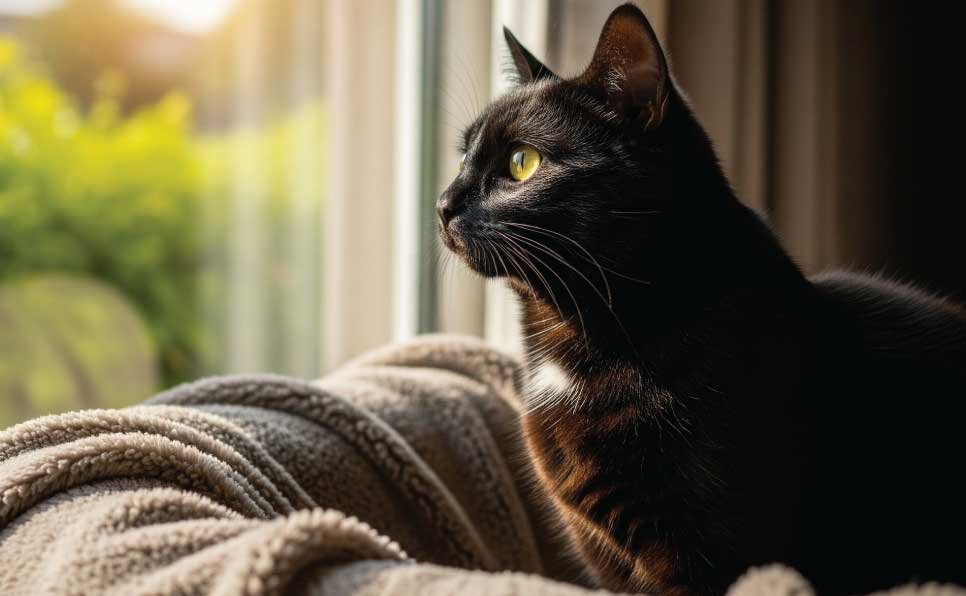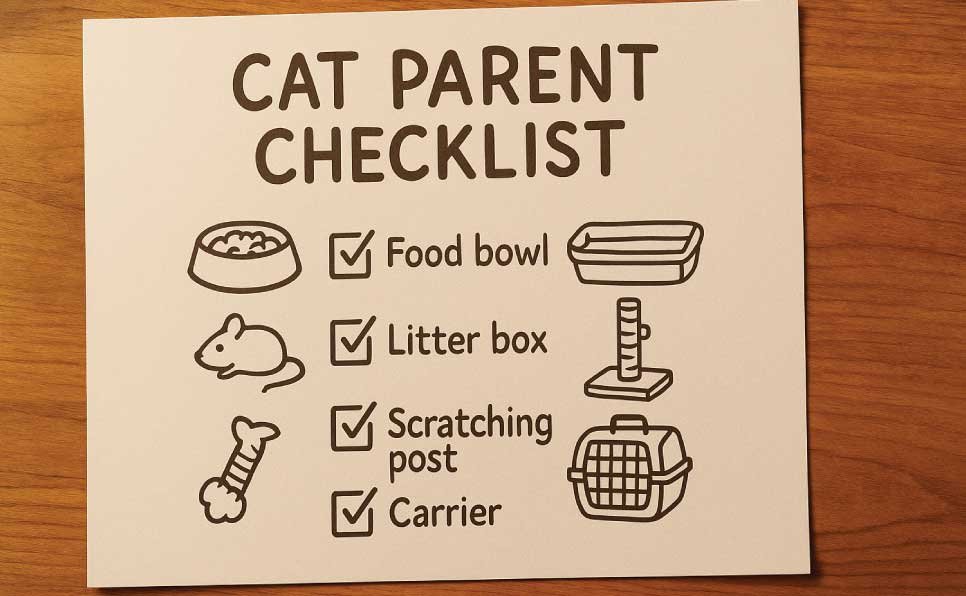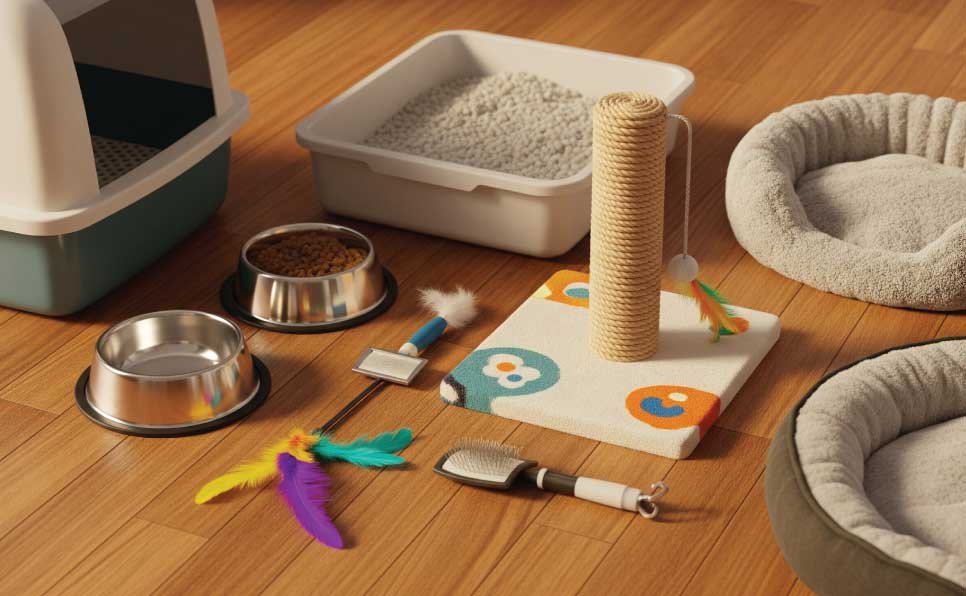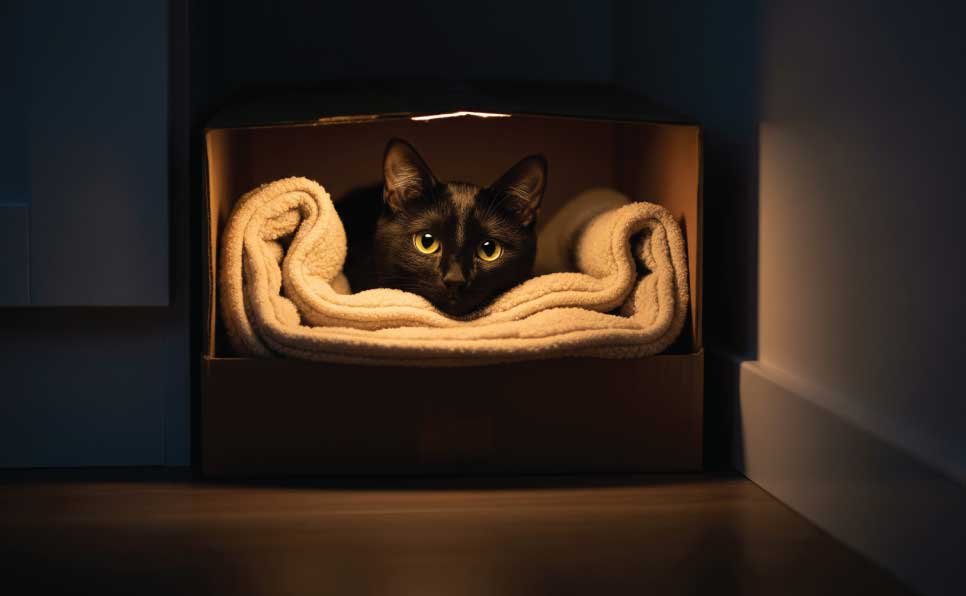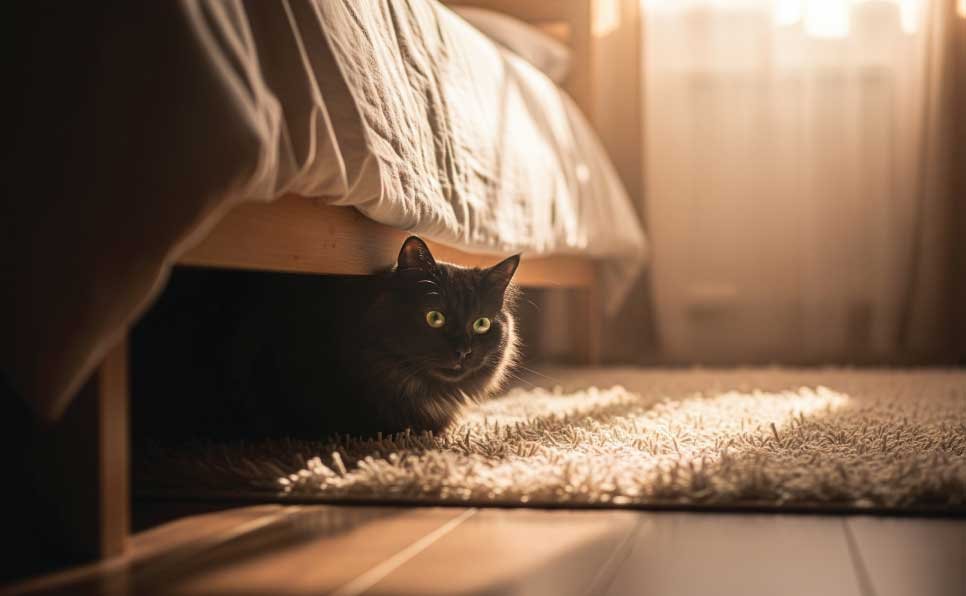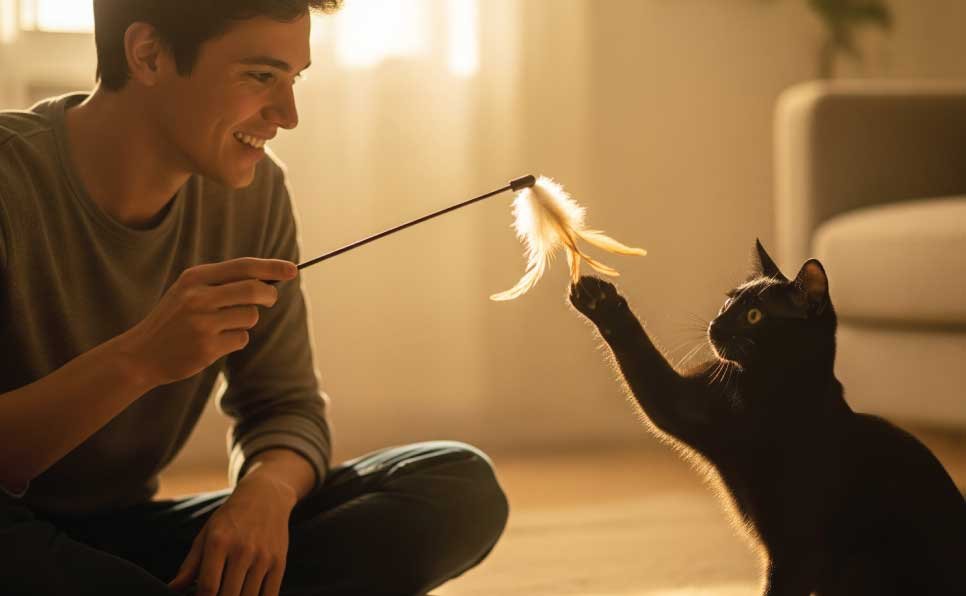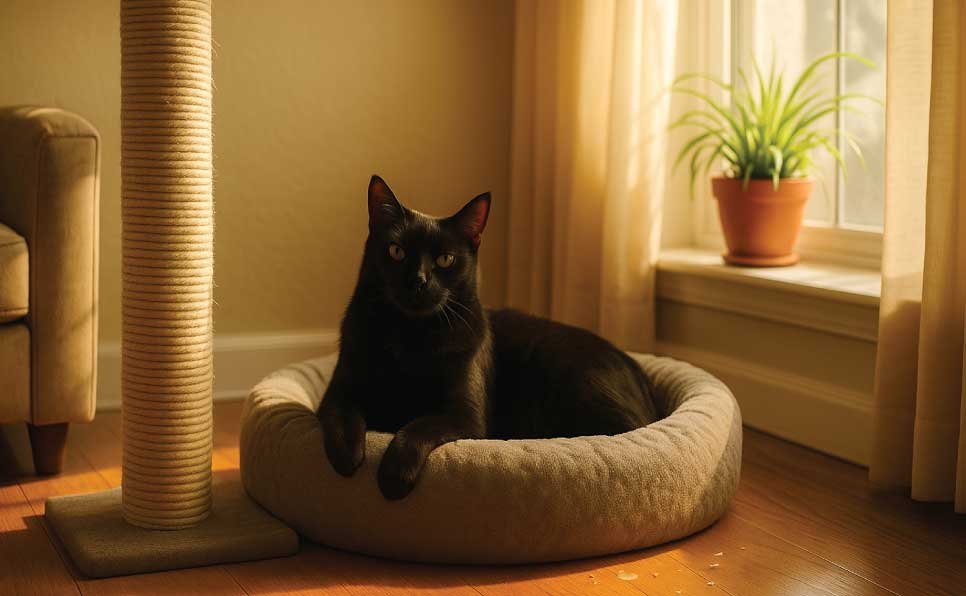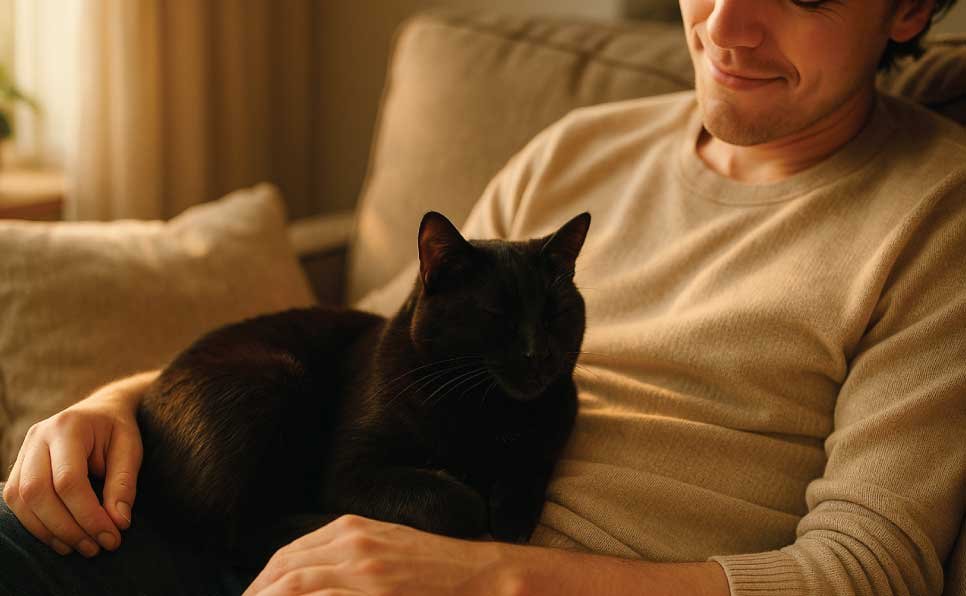Adopting a cat for the first time is one of the most rewarding and heartwarming decisions you can make. I remember when I brought Moussy home, my sweet black cat with soulful golden eyes and the softest fur that felt like velvet under my fingertips. He’d already endured so much by just 9 months old. He’d survived cruelty that cost him his tail, and carried the deep fear that comes from being in a world that hadn’t always been kind to him.
When I first opened the door to our shared life, I felt both excitement and nervousness. Could I give him what he needed? Would I know how to help him feel safe and loved? The weight of responsibility felt enormous as I watched this tiny, trembling creature peek out from his carrier.
If you’re standing at that door now, ready to welcome a cat into your heart and home, I want you to know you can do this. And I’m here to help you every step of the way.
In this guide, you’ll find a complete first-time cat adoption checklist, built not just from expert advice but from my own real-life experience with Moussy. Together, we’ll cover everything you need to prepare your home, choose essential supplies, navigate those crucial first days, and start building a bond that can last a lifetime.
You’ll learn:
- How to set up safe hiding spots and cat-proof your home
- The key supplies you really need (and what you can skip)
- How to navigate the first 24-48 hours with calm and confidence
- Tips for earning your cat’s trust and understanding their body language
This isn’t about perfection, it’s about creating a loving, peaceful space where your new companion can thrive. Let’s get started, so you can feel prepared, and your cat can feel at home from the moment they arrive.
Listen to the Podcast: First-Time Cat Adoption Checklist
Preparing Your Home Before Adoption
When I first brought Moussy home, I didn’t know how I could really take care for a cat and just how important it was to set up the house thoughtfully. The smell of his fear was almost tangible, that sharp, stressed scent that made my heart ache. I want to share what I learned while preparing a safe, loving space for him, so you can give your future feline friend the same sense of peace and security.
Creating Safe Hiding Spots for Comfort
This was absolutely crucial for Moussy. When he first arrived, he was terrified of everything, sudden noises, quick movements, even my shadow passing by. I quickly realized he needed little sanctuaries where he could feel invisible and safe.
What worked for us:
- Cardboard boxes with soft blankets inside, placed in quiet corners
- A cleared low shelf in my closet where he could tuck himself away
- Under my bed became his fortress for the first week
Pro tip: Use bedding that smells like you, I’d sleep with a small towel for a few nights, then place it in his hiding spot. It helped him associate my scent with safety rather than threat.
The golden rule: Respect their space completely. I’d sit nearby and read aloud softly, but never reached in to coax him out. Patience paid off, after five days, I saw a little black nose peeking out, and eventually, those golden eyes met mine with curiosity instead of fear.
Cat-Proofing Essentials
I learned this lesson the hard way when Moussy chewed through my phone charger on day three. Thankfully it was unplugged, but it was a wake-up call about the hidden dangers in our homes.
Safety checklist:
- Electrical cords: Tape them down or cover with cord protectors
- Toxic plants: I had to rehome my beloved peace lily, common houseplants like lilies, azaleas, and poinsettias can be deadly to cats
- Windows: Secure all screens properly; scared cats can bolt unexpectedly
- Small objects: Hair ties, rubber bands, and coins can cause choking or intestinal blockages
- Chemicals: Store cleaning supplies, medications, and cosmetics in locked cabinets
Setting Up Essential Areas
Moussy needed predictability in those early days. Keeping his food, water, and litter box in consistent locations helped reduce his anxiety about navigating this new world.
Space planning tips:
- Quiet feeding area: Choose a spot away from foot traffic where your cat can eat without feeling vulnerable
- Litter box placement: Far from food (cats are particular about this!) and easily accessible but private
- Sleeping spots: I set up a soft bed near a sunny window. Moussy ignored it for weeks, preferring his cardboard fortress, but now it’s his favorite afternoon nap spot
Essential Supplies Checklist
Walking through the pet store before Moussy arrived, I felt overwhelmed by the endless options. Looking back after 15 years together, I can tell you exactly what matters and what’s just marketing fluff.
Food and Water Bowls
My first mistake was buying cute plastic bowls that gave Moussy chin acne within a week. The switch to stainless steel made all the difference.
Best choices:
- Stainless steel or ceramic bowls: Easy to clean and better for your cat’s skin
- Shallow bowls: Essential if your cat has a flat face; deep bowls made Moussy uncomfortable
- Separate water source: Keep fresh water available 24/7, I learned Moussy preferred water that had been sitting out for a few hours rather than fresh from the tap
Litter Box and Litter
I started with a covered litter box thinking it would be tidier. Moussy hated feeling trapped and would hold it rather than use the box. The open, low-sided replacement was an immediate hit.
What I recommend:
- Open-top box: Most cats prefer to see their surroundings while vulnerable
- Low sides: Easier for kittens, seniors, or anxious cats to access
- Unscented, clumping litter: Strong fragrances overwhelmed Moussy’s sensitive nose
- Daily cleaning: This single habit prevented most litter box problems
Golden rule: One box per cat, plus one extra if you ever expand your family.
Cat Carrier
Our first vet visit taught me this lesson painfully. Moussy was terrified in the flimsy soft carrier I’d bought, shaking so hard I could feel it through the fabric.
Upgrade to:
- Hard-shell carrier: Provides security and stability
- Top-loading option: Much easier when your cat is nervous
- Cozy blanket inside: Use one that smells like home, Moussy would curl up on his even at the vet’s office
Scratching Posts and Toys
Moussy never touched my furniture because I gave him appealing alternatives from day one. The fancy electronic toys often sat unused while he played with crumpled paper balls.
Smart purchases:
- Variety of scratching surfaces: One vertical post and one horizontal scratcher
- Simple toys work best: Feather wands for interactive play, crinkle balls for solo entertainment
- Rotate toys: Keep a few out, store the rest, and swap them weekly to maintain novelty
Grooming Tools
With Moussy’s longer coat, grooming was essential but challenging at first. Starting with very short, gentle sessions made all the difference.
Basic kit:
- Slicker brush: Perfect for longer-haired cats
- Cat-safe nail clippers: Short, positive sessions work best
- Patience and treats: Make grooming something your cat looks forward to
The First 24-48 Hours: Setting the Foundation
I’ll never forget Moussy’s first night. He wedged himself so far under my bed that I could barely see him, just two golden eyes reflecting the hallway light. Those first 48 hours were about one thing: helping him feel safe enough to begin trusting.
Let Your Cat Set the Exploration Pace
Moussy’s world was one corner under my bed for the first three days. And that was perfectly okay.
The right approach:
- Start small: Set up one quiet room instead of giving access to the whole house
- Let them decide: I’d sit on the floor nearby, reading aloud or just being present
- No forced interactions: Every time I reached toward him, he’d shrink back. Patience was everything
What worked: After two days of simply coexisting in the same space, Moussy started showing curiosity. First, his nose would peek out when I talked. Then one golden eye. Eventually, he’d emerge when I wasn’t looking directly at him.
Keep Everything Calm and Quiet
The temptation to show off your new family member is strong, but resist it. Moussy needed peace to process his new reality.
Create a sanctuary:
- Minimize noise: Soft music, quiet conversations, gentle movements
- No visitors: Save the introductions for after your cat shows signs of settling in
- Consistent routine: Feed at the same times, keep lighting predictable
Introduce Family Members Gradually
Even though it was just Moussy and me, I had to learn how to be around a traumatized cat. If you have children or other pets, this step is crucial.
For families with kids:
- Teach gentle behavior: Quiet voices, slow movements, let the cat approach first
- Supervise all interactions: Even well-meaning children can overwhelm a nervous cat
- Create cat-free zones: Give your new pet places to retreat
For multi-pet households:
- Separate spaces initially: Keep new cat in one room while others adjust to new scents
- Scent swapping: Rub a towel on each animal and place it near the other’s food
- Gradual visual contact: Baby gates work well for this phase
Watch for Warning Signs
Moussy didn’t eat for the first 18 hours, which had me worried. By morning, hunger won over fear, but I learned what to monitor.
Red flags to watch for:
- Not eating or drinking for 24+ hours: Especially concerning in kittens or senior cats
- Complete hiding without any curiosity: Some hiding is normal, but zero interest in surroundings after 48 hours needs attention
- Respiratory symptoms: Sneezing, runny eyes, or difficulty breathing
- Litter box issues: Not using it at all, or signs of diarrhea/constipation
What I Wish I’d Known: That first week, I worried about every little thing. Moussy would sleep for hours, and I’d panic that something was wrong. Normal cat sleep is 12-16 hours per day, I just didn’t know that yet! Trust your instincts, but also remember that adjusting cats sleep a lot while processing their new environment.
Building a Bond With Your New Cat
If you’d told me on that first night, with Moussy trembling under the bed, that one day he’d curl up next to me purring so loud it sounded like a tiny motor, I wouldn’t have believed you. But here we are, 15 years later, and that bond is the most precious thing in my life.
Why Patience Trumps Everything
When Moussy first came home, I wanted desperately to hold him, to somehow communicate that he was safe now. But every time I got too close too fast, I’d see him shrink into himself, ears flattened, body tense.
The breakthrough moment: After a week of simply coexisting, I was reading on the floor when I felt the softest brush against my leg. Moussy had crept out and was investigating. I didn’t move, didn’t speak, and just let him decide. That tiny moment of his choice to touch me was worth more than any forced interaction could have been.
What I learned:
- Sit at their level: I spent a lot of time on the floor, making myself less intimidating
- Speak softly: I’d narrate what I was doing in gentle tones “I’m just making dinner, Moussy”
- Respect their “no”: When he’d retreat, I’d give him space without following
Using Food and Play to Build Trust
Once Moussy felt safer, treats and play became our common language. The first time he batted at a feather wand, eyes bright and focused, I nearly cried with joy.
Trust-building strategies:
- High-value treats: Small pieces of cooked chicken worked magic for Moussy
- Interactive play: Feather wands let us play together while maintaining distance
- Meal participation: I’d sit nearby while he ate, gradually moving closer over time
The mistake I made: I tried to rush things with treats, holding them too close to my body. Moussy would want the treat but fear getting too close to me. Tossing treats near him worked much better initially.
Reading Cat Body Language
Without his tail, I had to learn to read Moussy’s other signals. His ears, eyes, and body posture became my guide to his emotional state.
Key signals I learned:
- Ears forward: Curious, interested, or content
- Ears back or flattened: Scared, angry, or overwhelmed
- Slow blinks: The ultimate sign of trust, I’d slow blink back at him
- Relaxed body posture: When Moussy started lying on his side instead of crouched and ready to flee, I knew we were making progress
- Purring: His first purr, three weeks in, was the most beautiful sound I’d ever heard
The “almost ready” signs: Moussy would sit just out of reach, watching me intently. He’d follow me from room to room but maintain distance. These were signs he was interested but still building courage.
When Things Go Wrong
Not every day was progress. Sometimes Moussy would have setbacks, a loud noise would send him back under the bed for hours, or he’d suddenly seem afraid of me again.
What helped during tough moments:
- Don’t take it personally: Trauma recovery isn’t linear
- Back up to basics: Return to sitting quietly nearby without expectations
- Stay consistent: Keep routines the same even when they seem to be working backward
Common First-Week Challenges (And Solutions)
“My Cat Won’t Come Out of Hiding”
This was Moussy for the first four days. It felt like forever, but it was completely normal.
What to do:
- Ensure they have access to food, water, and litter box in their safe space
- Sit nearby and read aloud or talk softly
- Don’t force interactions or try to coax them out
- Most cats start exploring within 3-7 days
“My Cat Won’t Eat”
Moussy skipped his first meal entirely, which terrified me. Stress suppresses appetite, but there are ways to encourage eating.
Try these strategies:
- Warm the food slightly to enhance aroma
- Offer different textures, some cats prefer pâté, others chunks
- Hand-feed tiny amounts if they’ll take it
- If they refuse food for more than 24 hours, call your vet
“My Cat Keeps Trying to Hide Behind the Washer/Dryer”
Dangerous hiding spots are common problems. Moussy tried to squeeze behind appliances where he could get stuck.
Safety solutions:
- Block access to dangerous areas with cardboard or furniture
- Provide better hiding alternatives nearby
- Make their official hiding spots more appealing with comfort items
Setting Up for Long-Term Success
Creating Routines Your Cat Can Count On
Moussy thrived once he learned our daily rhythm. Consistency helped him feel secure and predict what came next.
Helpful routines:
- Regular feeding times: Twice daily for adults, more for kittens
- Daily play sessions: Even 10 minutes makes a difference
- Quiet time together: Reading while your cat naps nearby builds bonds
When to Schedule the First Vet Visit
I waited two weeks before taking Moussy to the vet, giving him time to settle but not delaying necessary care.
Timing recommendations:
- Within 2-3 weeks: Allows settling time but ensures health check
- Sooner if: Signs of illness, not eating/drinking, or litter box problems
- Bring comfort items: That familiar-smelling blanket helps at the vet’s office
Building Your Support Network
Having experienced cat people to call made all the difference during those uncertain early days.
Create your team:
- Veterinarian: Establish relationship early
- Cat-savvy friends: For advice and reassurance
- Online communities: But remember every cat is different
First-Time Cat Adoption Checklist. Frequently Asked Questions (FAQs)
It really depends on the cat’s personality and past experiences. Some cats feel comfortable in a few days, while others, especially those with difficult histories like Moussy, may take weeks or even months to fully relax. The key is patience, routine, and letting your cat set the pace.
For safety and health, it’s generally best to keep your newly adopted cat indoors, at least at first. Outdoor cats face risks like traffic, predators, and disease. If you want to give them safe outdoor time, consider a catio, harness training, or supervised outings once they’re settled.
Go slowly! Start by keeping them in separate rooms and swapping scents (like blankets or toys). Gradually let them see each other through a cracked door or baby gate before any direct contact. Short, calm, supervised meetings work best to avoid stress.
Check what your cat was eating before adoption and try to transition slowly to a new diet over about a week, if needed. Look for high-quality food appropriate for their age (kitten, adult, senior). When in doubt, ask your vet for guidance based on your cat’s health and history.
Yes, it’s a great idea to schedule a vet check-up within the first week or so. Even if your cat seems healthy, it’s important to establish care, check for parasites, update vaccines if needed, and discuss microchipping or spay/neuter if it hasn’t been done.
A little hesitation is normal in the first day or two as your cat adjusts. But if your cat goes more than 24-48 hours without eating or doesn’t use the litter box, contact your vet. It could be stress, but it’s always best to rule out a medical issue early.
Conclusion: The Journey is Worth Every Moment
Fifteen years later, as I write this with Moussy purring beside me, his black fur now touched with silver, those golden eyes still bright with trust, I can tell you that every patient moment in those early days was worth it. The scared, tailless kitten who hid under my bed became the confident, loving companion who greets me at the door and shares my daily life.
Your first-time cat adoption journey will be unique, but the foundations remain the same: patience, consistency, and respect for your cat’s pace. You’re not just bringing home a pet, you’re beginning a relationship that can bring joy, comfort, and companionship for many years to come.
Remember:
- Every cat adjusts differently, some take days, others take months
- Small progress is still progress
- Your calm, patient presence is the greatest gift you can offer
- The bond you’re building will be worth every moment of uncertainty
The scared little soul you bring home today could become your most treasured companion tomorrow. Trust the process, trust your instincts, and most importantly, trust that love and patience can heal almost anything.
Ready to take this journey? I’d love to hear about your adoption story! What questions do you have about welcoming your new family member home?
Wishing you and your future feline friend all the love and joy in the world.

